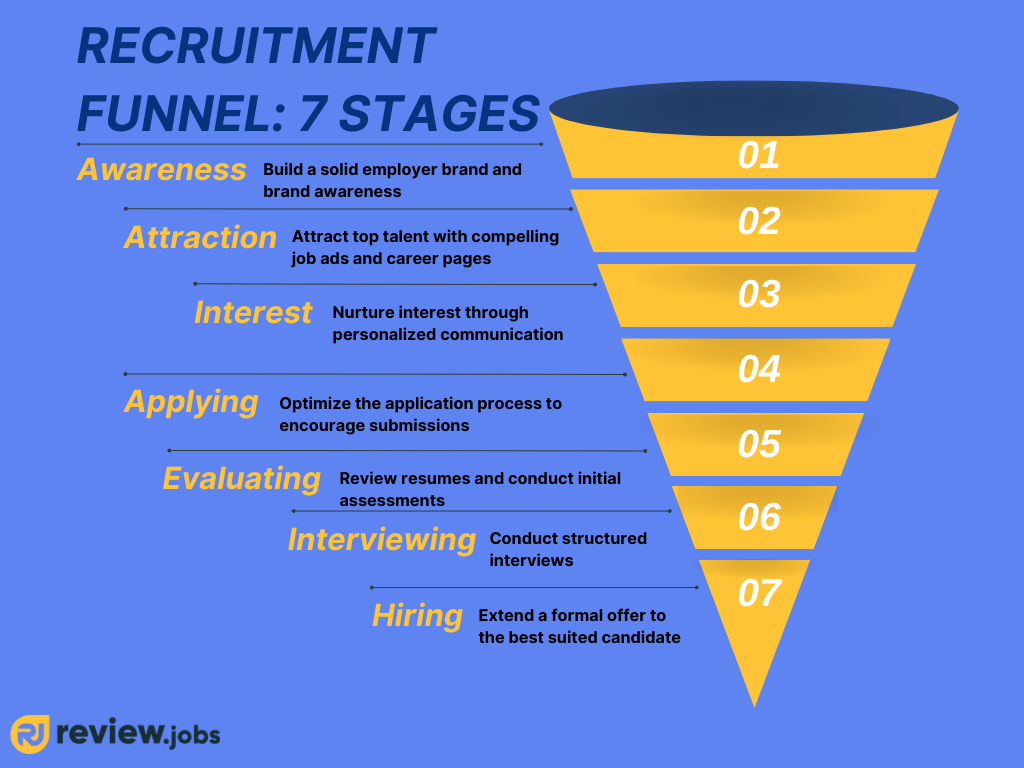The recruitment funnel is a cornerstone of modern hiring practices, providing a clear roadmap to guide potential candidates from their first exposure to your brand to their onboarding as valuable employees. At Review.jobs, we understand the importance of this strategic tool for HR professionals and recruiters aiming to attract top talent, improve candidate experience, and optimize every step of the hiring process. Whether you’re refining your employer brand, reducing drop-offs, or embracing data-driven recruiting, the recruitment funnel offers unparalleled clarity and effectiveness. Let’s dive into the intricacies, strategies, and best practices to create a recruitment funnel that positions your company as a leader in the competitive talent acquisition landscape.
Table of Contents
What is a Recruitment Funnel?
The recruitment funnel is a structured representation of the stages a candidate goes through, from becoming aware of a job opportunity to being hired. It visually maps out the hiring process, much like a sales funnel, emphasizing a step-by-step progression designed to attract and engage potential candidates while identifying top talent efficiently.
This strategic framework breaks down the recruitment journey into distinct stages, from initial awareness of your company to the final onboarding of a new hire. These stages include awareness, attraction, interest, application, evaluation, interviewing, and hiring. Each stage narrows the candidate pool, ensuring that only the most qualified individuals progress further.
For example:
- At the awareness stage, you might engage thousands of passive candidates through social media or employer review platforms like Review.jobs.
- By the hiring stage, you’ve identified and onboarded the one or two individuals who best match the role and your company culture.
Purpose of a Recruitment Funnel
The primary purpose of a recruitment funnel is to create a streamlined and efficient hiring process that balances the needs of the employer and the candidate. It offers numerous advantages:
Clarity and Organization
Breaking the recruitment process into stages provides a clear overview, helping HR teams understand how candidates move through the funnel and where improvements can be made.
Resource Allocation
By identifying which stages need more attention—such as sourcing candidates or conducting interviews—companies can allocate time, technology, and budget more effectively.
Enhanced Candidate Experience
A structured funnel ensures that candidates are not left in the dark at any stage. Clear communication and timely updates foster a positive experience, which is crucial for maintaining a strong employer brand.
Improved Decision-Making
The recruitment funnel encourages data-driven recruiting by allowing you to track metrics like time-to-fill, cost-per-hire, and quality-of-hire. These insights help refine strategies and optimize outcomes.
Alignment with Business Goals
By focusing on the recruitment funnel, HR teams can align their efforts with organizational objectives, such as attracting top talent, improving retention rates, or meeting diversity and inclusion goals.
Importance of Visualization
Visualizing the recruitment funnel transforms a complex hiring process into a clear, manageable framework. Here’s why it’s essential:
- Simplifies Complexity: Breaks down the hiring journey into distinct stages, making workflows clear and ensuring team alignment.
- Identifies Bottlenecks: Pinpoints drop-offs, such as application abandonment or delays in interviews, enabling targeted improvements.
- Enhances Candidate Experience: Ensures a smooth, consistent process with timely updates, reducing frustration and boosting engagement.
- Enables Data-Driven Decisions: Highlights key metrics like time-to-fill or offer acceptance rate, providing actionable insights for optimization.
Why Recruitment Funnels Matter in 2024
Current Challenges in Hiring
In 2024, hiring professionals face numerous challenges stemming from evolving workforce expectations, technological advancements, and competitive labor markets. Understanding these challenges is essential for developing effective recruitment strategies that attract and retain top talent.
1. Intense Competition for Top Talent
With globalization and remote work opportunities expanding, the best candidates now have more job options than ever.
- Highly Competitive Market: Companies are not only competing locally but globally for skilled professionals.
- Demand for Specialized Skills: As industries become more tech-driven, there’s an increased focus on hiring talent with niche expertise, particularly in fields like AI, data science, and cybersecurity.
- Impact on Employer Brand: A strong employer brand is essential to stand out in this crowded landscape. Platforms like Review.jobs help showcase your workplace culture and attract potential candidates.
2. Remote Work Trends and Expectations
The shift to remote work has changed how companies attract, evaluate, and manage employees.
- Hybrid Work Models: Candidates increasingly expect flexibility, with many prioritizing roles that offer remote or hybrid options.
- Global Hiring Challenges: Remote hiring widens the talent pool but introduces complexities in terms of compliance, time zones, and cultural differences.
- Retention Risks: Employees dissatisfied with rigid work policies may seek opportunities elsewhere, further intensifying the battle for talent.
3. Focus on Diversity, Equity, and Inclusion (DEI)
Organizations are under pressure to meet DEI goals, but achieving them isn’t always straightforward.
- Broadening Talent Pools: Traditional recruitment practices may inadvertently exclude diverse candidates.
- Unconscious Bias: Despite progress, biases in screening, interviewing, and hiring decisions remain a significant hurdle.
- DEI Metrics: Companies need to track and improve recruitment funnel metrics to align hiring practices with DEI objectives.
4. Lengthy and Inefficient Hiring Processes
An overly complex or lengthy hiring process often leads to high candidate attrition rates.
- Time-to-Fill Challenges: Delays in decision-making can cause companies to lose candidates to faster-moving competitors.
- Candidate Drop-Off: Complicated application processes or unclear communication can frustrate candidates, leading them to abandon the process.
- Streamlining Needed: Tools like an applicant tracking system (ATS) or automation can help reduce inefficiencies.
5. Skills-Based Hiring Revolution
The shift from traditional qualifications to skills-based hiring has introduced both opportunities and challenges.
- Redefining Job Descriptions: Employers must craft job descriptions that emphasize required skills rather than degrees or specific experience levels.
- Assessing Skills: Pre-employment tests and skills-based hiring tools are essential but require thoughtful implementation to avoid bias.
6. Candidate Expectations and Experience
Candidates now expect a personalized, efficient, and engaging candidate experience throughout the recruitment process.
- Transparency: Candidates want clear job roles, timelines, and feedback at every stage of the recruitment funnel.
- Tech-Savvy Processes: Mobile-friendly applications, chatbots for real-time answers, and user-friendly portals are no longer optional.
- Workplace Values: Many candidates prioritize organizations with strong values, sustainability practices, and employee well-being initiatives.
The 7 Stages of the Recruitment Funnel
The recruitment funnel comprises several stages, each crucial for moving candidates through the hiring pipeline. Let’s break them down:

1. Awareness
At the top of the funnel, candidates become aware of your company and its opportunities. It’s your first chance to make an impression.
- Building Employer Brand Visibility: Showcase your company culture and values using platforms like Review.jobs. Share behind-the-scenes content, employee testimonials, and achievements on social media platforms.
- Strategies to Attract Passive Candidates: Use targeted advertising, engaging blog posts, and employer review sites to appeal to candidates who aren’t actively job hunting.
- Metrics to Measure Success: Track website traffic, social media followers, and engagement rates to assess awareness efforts.
2. Attraction
At this stage, the focus shifts to converting passive interest into active engagement.
- Crafting Standout Job Descriptions: Write clear, compelling, and inclusive job descriptions that outline the role, company culture, and benefits.
- Targeted Advertising: Use paid ads on job boards, LinkedIn, and niche platforms to reach specific audiences.
- Creative Engagement: To capture attention, consider gamified application challenges or interactive job ads.
3. Interest
Once candidates show interest, keep them engaged by providing valuable, accessible information. LinkedIn reports that 53% of candidates gather information about a company through its website, 38% rely on LinkedIn, and 32% turn to contacts within the organization.
- Optimizing Digital Presence: Ensure your website, LinkedIn, and Glassdoor profiles are updated with current roles, team highlights, and company values.
- Accessible Resources: Provide FAQs, instructional videos, and clear application guidelines to reduce confusion.
4. Application
Simplifying the application process is vital for keeping candidates interested.
- Using ATS Tools: Implement an applicant tracking system to streamline applications, enabling easy resume uploads and tracking progress.
- Reducing Drop-Off Rates: Make applications mobile-friendly and concise, and provide clear instructions to avoid frustration.
5. Evaluation
At this stage, the focus is on assessing the qualifications and cultural fit of candidates.
- Skill-Based Hiring: Use pre-employment tests and case studies to evaluate skills objectively.
- Unbiased Screening Methods: AI tools can help reduce unconscious bias and ensure fair assessments.
6. Interviewing
The interview stage is where both employer and candidate gain deeper insights into each other.
- Structured Interviews: Create a consistent format with a mix of technical, behavioral, and situational questions.
- Remote Interview Best Practices: Test technology beforehand, and ensure candidates feel comfortable in virtual settings.
7. Hiring
This is the final stage, where offers are extended, and candidates are onboarded.
- Crafting Compelling Offers: Highlight the role’s growth opportunities, benefits, and alignment with the candidate’s goals.
- Seamless Onboarding: Start onboarding once the offer is accepted to reinforce the candidate’s decision.
Common Pitfalls in Recruitment Funnels and How to Avoid Them
While the recruitment funnel is an effective framework, there are several pitfalls that can hinder its efficiency. These challenges often result in lost opportunities, wasted resources, and poor candidate experiences. Understanding and implementing strategies to avoid these pitfalls is essential for optimizing your recruitment process.
Candidate Attrition
Candidate attrition, or the drop-off of candidates at various stages, is one of the most common issues in the hiring funnel.
Causes of Candidate Attrition
- Overly Complex Application Processes: Lengthy forms or unclear instructions deter candidates.
- Poor Communication: A lack of timely updates can frustrate candidates and lead to disengagement.
- Unengaging Experiences: Candidates may lose interest if the process feels impersonal or outdated.
How to Avoid It
- Streamline the Application Process: Use mobile-friendly applications, concise forms, and clear instructions to minimize barriers.
- Ensure Timely Communication: Keep candidates informed at every stage with automated updates through an applicant tracking system (ATS).
- Engage Candidates Throughout: Provide a personalized experience by using tools like chatbots and offering insights into company culture through platforms like Review.jobs.
Lack of Data-Driven Decision Making
With proper data analysis, companies can gain key insights into their funnel recruitment performance.
Challenges of Data Blindness
- Inefficiency in Identifying Bottlenecks: Without metrics, it’s hard to pinpoint where candidates are dropping off.
- Missed Opportunities for Improvement: Recruitment strategies can stagnate without insights from funnel stages.
Key Metrics to Track
| Metric | Definition | Importance |
| Time-to-Fill | Days from job posting to hire | Identifies bottlenecks in the process. |
| Offer Acceptance Rate | Percentage of accepted offers | Highlights offer competitiveness. |
| Quality-of-Hire | Performance of hires over time | Evaluates long-term recruitment success. |
Overlooking Employer Branding
Employer branding is the foundation of your recruitment efforts. In fact, 75% consider an employer’s brand before applying for a job. A weak or poorly communicated employer brand can deter top talent from entering the funnel.
Branding Pitfalls
- Inconsistent Messaging: Candidates may receive conflicting signals about company culture, values, or opportunities.
- Lack of Visibility: Companies that don’t invest in social media platforms or employee review sites like Review.jobs fail to attract passive candidates.
How to Avoid It
- Strengthen Employer Branding: Showcase your company culture, values, and employee stories across all channels.
- Leverage Employee Advocacy: Encourage employees to share positive reviews and testimonials online.
- Utilize Review Platforms: Platforms like Review.jobs can enhance visibility and credibility, attracting potential candidates.
Ignoring Candidate Feedback
Many organizations fail to collect or act on candidate feedback, leading to repeated mistakes and poor candidate experience.
Feedback Pitfalls
- Unresolved Pain Points: Candidates might abandon the process due to unresolved frustrations, such as poor interview experiences or unclear job expectations.
- Negative Employer Brand Impact: Dissatisfied candidates may share their experiences publicly, harming your reputation.
How to Avoid It
- Actively Collect Feedback: Use surveys or follow-ups to ask candidates about their experiences.
- Implement Changes Based on Feedback: Address common complaints, such as unclear job descriptions or delayed communication.
- Monitor Online Reviews: Platforms like Review.jobs provide insights into how candidates perceive your recruiting funnel.
Failure to Adapt to Technology
Relying on outdated tools or ignoring the latest technology trends can result in inefficiencies and missed opportunities.
Technology Pitfalls
- Manual Processes: Time-consuming manual tasks can delay stages like evaluation and communication.
- Poor Integration: Disconnected systems can lead to data silos, reducing the efficiency of your recruitment funnel framework.
How to Avoid It
- Adopt Modern Tools: Use AI-driven tools for skills-based hiring, pre-employment assessments, and automated screening.
- Integrate Technology: Ensure your applicant tracking system works seamlessly with other HR platforms.
- Stay Updated: Regularly evaluate and upgrade systems to meet the needs of your recruitment process.
Strategies to Optimize Your Recruitment Funnel
1. Employer Branding
A strong employer brand attracts top talent and improves every stage of the recruitment funnel.
- Showcase employee stories on social media platforms.
- Leverage employee reviews on Review.jobs to enhance your reputation.
2. Leveraging Technology
AI-driven tools and automation are game-changers in recruitment.
- Use AI for candidate screening and matching based on skills and experience.
- Automate communication through chatbots to keep candidates informed.
3. Continuous Improvement
Optimization is an ongoing process.
- Collect candidate feedback after interviews and applications.
- Analyze funnel data to identify stages with high attrition rates.
The Role of Employee Reviews in Enhancing Recruitment Funnels
Employee reviews are a goldmine for improving your recruitment funnel. Positive reviews not only attract candidates but also boost the employer brand.
- Leveraging Review Platforms: Use Review.jobs to highlight workplace culture, growth opportunities, and employee satisfaction.
- Encouraging Positive Reviews: Foster a culture of recognition and engagement, making employees more likely to share positive feedback.
At Review.jobs, we empower companies to optimize their recruitment funnel by leveraging data, technology, and employee feedback. Build a recruitment process that attracts, engages, and retains top talent while positioning your organization as a great place to work. Start your journey today with Review.jobs!





